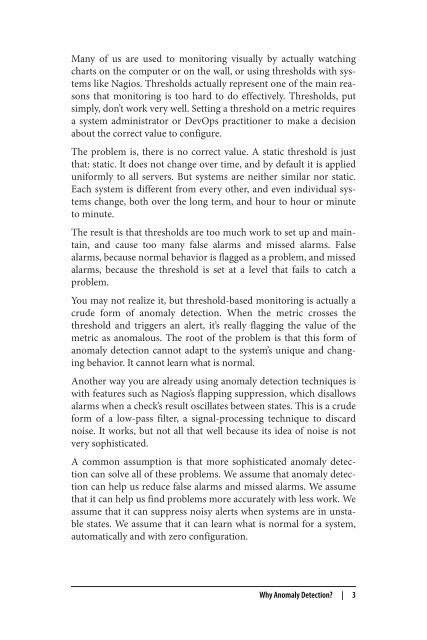Anomaly Detection for Monitoring
anomaly-detection-monitoring
anomaly-detection-monitoring
Create successful ePaper yourself
Turn your PDF publications into a flip-book with our unique Google optimized e-Paper software.
Many of us are used to monitoring visually by actually watching<br />
charts on the computer or on the wall, or using thresholds with systems<br />
like Nagios. Thresholds actually represent one of the main reasons<br />
that monitoring is too hard to do effectively. Thresholds, put<br />
simply, don’t work very well. Setting a threshold on a metric requires<br />
a system administrator or DevOps practitioner to make a decision<br />
about the correct value to configure.<br />
The problem is, there is no correct value. A static threshold is just<br />
that: static. It does not change over time, and by default it is applied<br />
uni<strong>for</strong>mly to all servers. But systems are neither similar nor static.<br />
Each system is different from every other, and even individual systems<br />
change, both over the long term, and hour to hour or minute<br />
to minute.<br />
The result is that thresholds are too much work to set up and maintain,<br />
and cause too many false alarms and missed alarms. False<br />
alarms, because normal behavior is flagged as a problem, and missed<br />
alarms, because the threshold is set at a level that fails to catch a<br />
problem.<br />
You may not realize it, but threshold-based monitoring is actually a<br />
crude <strong>for</strong>m of anomaly detection. When the metric crosses the<br />
threshold and triggers an alert, it’s really flagging the value of the<br />
metric as anomalous. The root of the problem is that this <strong>for</strong>m of<br />
anomaly detection cannot adapt to the system’s unique and changing<br />
behavior. It cannot learn what is normal.<br />
Another way you are already using anomaly detection techniques is<br />
with features such as Nagios’s flapping suppression, which disallows<br />
alarms when a check’s result oscillates between states. This is a crude<br />
<strong>for</strong>m of a low-pass filter, a signal-processing technique to discard<br />
noise. It works, but not all that well because its idea of noise is not<br />
very sophisticated.<br />
A common assumption is that more sophisticated anomaly detection<br />
can solve all of these problems. We assume that anomaly detection<br />
can help us reduce false alarms and missed alarms. We assume<br />
that it can help us find problems more accurately with less work. We<br />
assume that it can suppress noisy alerts when systems are in unstable<br />
states. We assume that it can learn what is normal <strong>for</strong> a system,<br />
automatically and with zero configuration.<br />
Why <strong>Anomaly</strong> <strong>Detection</strong>? | 3




